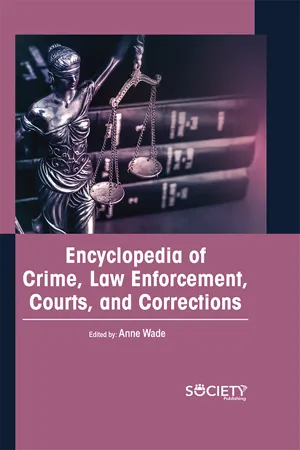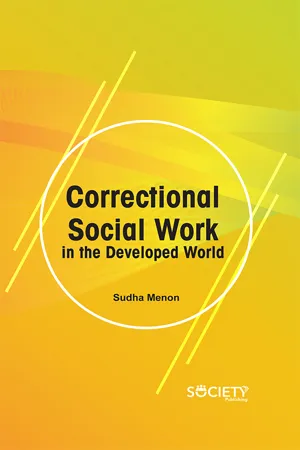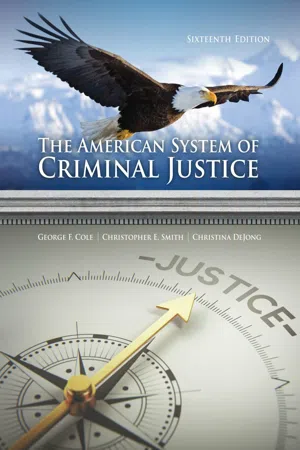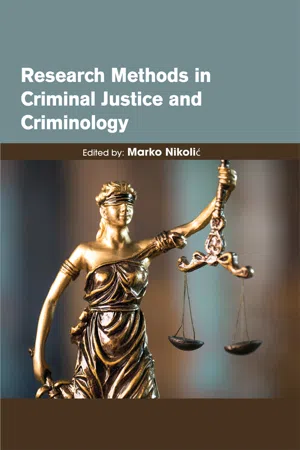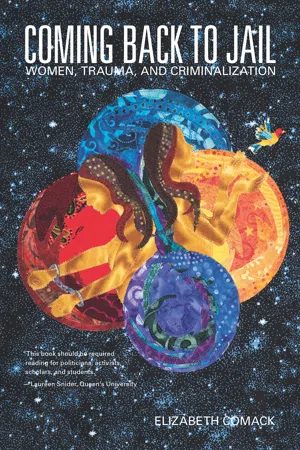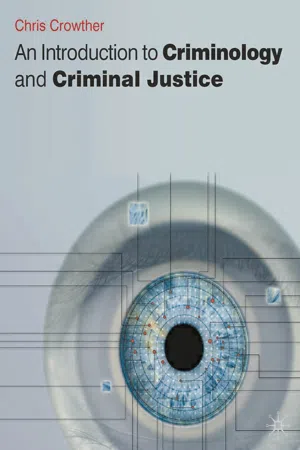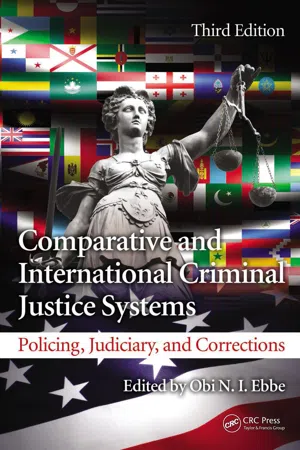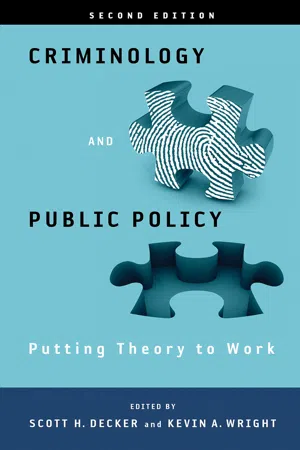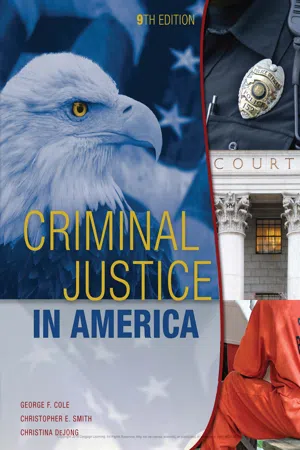Social Sciences
Criminal Justice System
The criminal justice system refers to the network of institutions and practices responsible for upholding social control, deterring and mitigating crime, and administering justice. It encompasses law enforcement, the judiciary, and correctional facilities, aiming to maintain order, protect individual rights, and ensure fair treatment for all involved in the legal process.
Written by Perlego with AI-assistance
Related key terms
1 of 5
10 Key excerpts on "Criminal Justice System"
- Anne Wade(Author)
- 2023(Publication Date)
- Society Publishing(Publisher)
A police officer in a patrol car responds to an armed robbery call, and the film depicts the officer’s viewpoint on his responsibilities. It depicts the 911 emergency system, the usage of computers, the criminal’s pursuit and capture, police station procedures, and the start of the prosecution (Cullen, 2007). The Criminal Justice System, which deals with convicted offenders, includes both government and non-government institutions. The Criminal Justice System is supported by academics, law enforcement, forensic services, the judiciary, and prisons. These structures protect the foundations of judicial justice. Legal justice can be realized only when the individual’s rights are connected to the government’s commitment to preserve and defend those rights. These fundamental rights cannot be maintained or preserved without the unwavering commitment of those who work in the Criminal Justice System. The ethical norms of the Criminal Justice System necessitate that these professionals follow them and always maintain their moral integrity (Hemmens, 2016). When properly implemented, these systems employ a diverse range of criminal justice professionals, including police officers, corrections officers, probation and parole officers, judges, attorneys, paralegals, mental health professionals, and paraprofessionals, as well as a code of professional ethics that denotes competence, dependability, accountability, and overall trustworthiness. Professional organizations, as well as people within these organizations, hold varying perspectives on criminal behavior, punishment, and rehabilitation (Figure 9.1). Understanding the Criminal Justice System 239 Figure 9.1. Detective analyzing a case. Source: https://media.istockphoto.com/photos/investigator-at-his-workplace- stock-photo-picture-id1311081066?k=20&m=1311081066&s=612x612&w=0 &h=a0ndBmhmJlJKqRb62vM7MZLl7QzEugQEZvIKqmqZySA=.- Sudha Menon(Author)
- 2023(Publication Date)
- Society Publishing(Publisher)
6.9.1. Community Includes the people, society, and various organization. The community plays a very important role in shaping the offender during the trial period and after the tenure of punishment. It protects the offender from abuse, cruelty, discrimination, and tries to make the offender constructive in nature so that he is acceptable to the society. 6.9.2. Law Enforcement It involves the government agencies responsible for the enforcement of penal laws. Its main aim is to establish whether the offender is responsible for the crime committed and is primarily involved in investigation of crime. 6.9.3. Prosecution Service Is mainly involved in evaluation of evidence in preliminary inquest investigation and dismisses or files the case against the offender. Correctional Social Work in the Developed World 136 6.9.4. Court The court is designated to handle and try the cases and issue judgment after trial. 6.9.5. Correctional System Refers to the institutions both correctional and rehabilitation programs for the offenders. The programs are involved in enhancing the skills and abilities of offender, facilitate in reintegration into the community, and lead a normal life. 6.10. IMPORTANCE OF Criminal Justice System (CJS) The CJS plays an important role in our society. Keeping the communities safe and maintain law and order is the top priority of CJS. The three main components of CJS are law enforcement, courts, and corrections. The proper functioning of all three components is necessary for maintaining proper law and order in society. Some criminal justice initiatives use evidence in the form of biological evidence like DNA to improve criminal justice outcomes. It helps to provide justice to innocent individuals who are wrongly convicted. The DNA evidence is used to identify suspects in residential and commercial burglaries and thefts. The National Institute on Drug Abuse (NIDA) focuses on substance abuse treatment for criminal justice settings.- eBook - PDF
- George Cole, Christopher Smith, Christina DeJong, , George Cole, Christopher Smith, Christina DeJong(Authors)
- 2018(Publication Date)
- Cengage Learning EMEA(Publisher)
Editorial review has deemed that any suppressed content does not materially affect the overall learning experience. Cengage Learning reserves the right to remove additional content at any time if subsequent rights restrictions require it. 8 PART 1 Crime and the Criminal Justice System aspects of law enforcement administration. Clearly, criminal justice pro- vides a multidisciplinary area of study that appeals to people with varied interests and expertise. An understanding of the crime problem and U.S. society’s definition of this problem as a public policy issue will give you the groundwork for later discus- sions about criminal justice as a social system in which actors and agencies interact and make decisions. To guide your study, we address the following themes. Crime and Justice as Public Policy Issues Who bears responsibility for addressing issues of crime and justice? The an- swer to this question depends on the organization of a society and the nature of its governing system. Looking back at human history, one can see many approaches to crime and punishment. For example, in a sparsely populated ru- ral society that lacked effective control by government, crime and justice were often viewed as private matters. When one individual harmed another through violence or theft, a measure of justice could be obtained through vengeful acts by the victim’s family or through the payment of compensation by the perpetra- tor. Such approaches were common in the centuries before central governments became dominating forces in modern nations. Alternatively, local leaders could rely on cultural traditions to impose punishments upon wrongdoers. In the United States, by contrast, crime and justice are public policy is- sues, because the government addresses them. Institutions and processes of government produce laws to define crimes; create and operate agencies to in- vestigate, prosecute, and punish criminals; and allocate resources to address the problems of crime and justice. - Marko Nikolic(Author)
- 2019(Publication Date)
- Society Publishing(Publisher)
Criminal Justice: A Global Perspective 1 CONTENTS 1.1. Introduction ........................................................................................ 2 1.2. Global Perspective of Criminal Justice ................................................. 4 1.3. Objectives of Criminal Justice System (CJS) ......................................... 9 1.4. Integrity In The Criminal Justice System (CJS) ...................................... 9 1.5. How The Criminal Justice Process Works .......................................... 16 References ............................................................................................... 22 Research Methods in Criminal Justice and Criminology 2 Criminal Justice is the most important aspect of the society in the modern times. It is very important to understand the functioning of the Criminal Justice System (CJS). With the dawn of technology, the whole world has turned into a closed community. This means that the global perspective of the Criminal Justice has to be altered or transformed in order to make it progress with the advancements in the world. With the inclusion of the Global perspective as the important aspect of Criminal Justice, the members who are a part of the CJS has an opportunity to evolve more in their field. Closed community – good sentence but wrong formulation if you want to say that technology opened the country borders and that communication made a closed community of the world through globalization process, that’s ok, but you need to explain this idea better… 1.1. INTRODUCTION From the day of the establishment of the civilization on this earth, the system of justice was established to counter the criminal activities. From that day, the judicial system has advanced in order to provide justice to the citizens of the world. The judicial system is broadly classified into two major classes: The Civil Justice and Criminal Justice.- eBook - PDF
Coming Back to Jail
Women, Trauma, and Criminalization
- Elizabeth Comack(Author)
- 2021(Publication Date)
- Fernwood Publishing(Publisher)
131 CHAPTER FIVE INVOLVEMENT WITH THE Criminal Justice System I n popular thought crime is a relatively straightforward matter confined to the actions of wrongdoers or offenders. Legal codes and official statistics promote this understanding. The codes and statistics alike break crime down into discrete categories (against persons, against property) and delineate specific offences (assaults, robberies, theft) for which people are charged and held accountable by the Criminal Justice System. At the same time, society promotes the Criminal Justice System as a fairly well-oiled machine dispensing justice, with clearly delineated roles for each of the legal actors. The police are crime fighters whose job is to investigate and apprehend suspects. Crown attorneys, acting on behalf of the state, take on the role of pursuing charges by meeting the burden of proof and establishing the guilt of the accused “beyond a reasonable doubt.” Defence lawyers not only ensure that the Crown proves its case beyond that “reason- able doubt” but also see that the investigation and prosecution of the offence does not violate the accused’s rights. Judges serve to determine the guilt or innocence of the accused and, if the finding is guilty, apply the appropriate punishment. This way of framing crime and the work of the criminal jus- tice system easily leads to the view that the individuals who are the focus of criminal justice intervention constitute the “criminal Other.” They are separate and apart from the “rest of us,” the law-abiding. For the most part these popular constructions of crime and the Criminal Justice System tend to be taken for granted. - Chris Crowther-Dowey(Author)
- 2017(Publication Date)
- Red Globe Press(Publisher)
PART THREE The Criminal Justice System in Context INTRODUCTION This chapter introduces the Criminal Justice System in the United Kingdom, and its policy-making processes in relation to the welfare state and society as a whole. Taking the Criminal Justice System in England and Wales as an example, it charts its emer-gence and the philosophical and political values that underpin its workings, and how these affect suspects, defendants and the convicted, as well as victims of crime in different social groups (categorized by class, gender, age and race). It discusses what is meant by the concept of justice in relation to crime, from legal and sociological perspectives. The central argument is that the criminal justice process cannot be understood in isolation from the many complex causes and consequences of, and responses to, crime. The chapter consists of four main parts. First, the structure of the criminal justice The Criminal Justice System and its Processes 5 OVERVIEW This chapter aims to provide: ឣ an initial introduction to the Criminal Justice System, highlighting the role of the state and central government ឣ a description of the welfare state and social policy, drawing attention to the relationship between different areas of public policy and criminal justice ឣ a brief introduction to debates about welfare and crime ឣ a discussion of the centrality of the idea of justice to crime policy, with reference to the control of offenders ឣ an understanding of the major influence of managerialism on crime and public policy. system is outlined, referring to the Home Office, the police service, the magistrates’ and Crown courts, and the prison and probation services. The chapters that follow are each dedicated to examining the work of one of these agencies, and a final chapter looks at attempts to join up the activities of these different players. The core aim of this section is to put it across that there is a system, and within this system there a range of processes.- eBook - PDF
- Ian Shaw, Katharine Briar-Lawson, Joan Orme, Roy Ruckdeschel, Ian Shaw, Katharine Briar-Lawson, Joan Orme, Roy Ruckdeschel(Authors)
- 2009(Publication Date)
- SAGE Publications Ltd(Publisher)
For these reasons, we delib-erately use the term loosely. Before proceeding, we offer two further caveats. Firstly, it is inevitable that our cover-age of the questions outlined above will be partial at best and idiosyncratic at worst; we can provide neither a global overview nor a comprehensive analysis. Secondly, we have resisted the temptation to include specific sections on issues concerning relationships between CJSW and poverty, social exclu-sion, diversity, race, gender and indigeniza-tion; this is because we prefer to treat these as recurring issues throughout the chapter. SOCIAL WORK, CRIMINAL JUSTICE AND RESEARCH Criminal justice processes and social work CJSW involves practice in formal Criminal Justice Systems, as well as in alternative and diversionary systems. Of course other areas of social work, such as child protection and 448 THE SAGE HANDBOOK OF SOCIAL WORK RESEARCH mental health, also have connections with the Criminal Justice System on a regular basis. For the sake of clarity, criminal justice includes systems or processes of criminal law, law enforcement, prosecution and defence, court adjudication and sentencing and the administration of sentences both in the com-munity and in institutions. Separate youth justice systems are common and social work has a long history of involvement with young offenders. Although court missionaries – who may be seen in some senses as the precursors of professional CJSW – ministered to all of those in need at court (see Nellis, 2007), services to victims and witnesses are a more recent innovation in the Criminal Justice System. Since social work with offenders – as opposed to victims – has dominated the history of CJSW and so will dominate this chapter, it makes some sense to dwell briefly here on social work with victims of crime. The evolution of work with victims owes much to social work’s wider interests and loyalties. - eBook - PDF
Comparative and International Criminal Justice Systems
Policing, Judiciary, and Corrections, Third Edition
- Dale June, Obi N. I. Ebbe(Authors)
- 2013(Publication Date)
- Routledge(Publisher)
54 42 Comparative and International Criminal Justice Systems GENERAL OVERVIEW B RIEF H ISTORY The contemporary American system of criminal justice is a result of centuries of evolution and social change. American colonists settling in the New World brought the criminal procedures, courts, and crime definitions of the English common law traditions along with them (Henderson 1985). This tradition originally did not define crimes or their remedies as public matters, but rather considered them to be private matters between the individual who was wronged and the wrongdoer (Siegel 1992). Later, the concept of public crime devel-oped, but it was confined to acts committed against the king, with individuals and their families left to resolve their own disputes. Church representatives handled those acts considered to be sinful, and local courts dealt with most secular violations. Because royal administrators were not constantly present in each community, a sys-tem was developed for holding court sessions in each county several times a year. The royal administrator, or judge, used local customs and rules of conduct as a guide for determining an appropriate sentence for an offender (Siegel 1992). The structure and content of this English system was modified to meet different community needs and geographic circumstances in the New World (Chapin 1983). Early in the development of the American system of justice, the framers of the U.S. Constitution (1787) gave Congress considered latitude to “establish inferior courts, to define crimes and stipulate punishments, and to provide for modes of process and procedures to be used in the courts” (Henderson 1985). - eBook - PDF
Criminology and Public Policy
Putting Theory to Work
- Scott H. Decker, Kevin A. Wright, Scott H. Decker, Kevin A. Wright(Authors)
- 2018(Publication Date)
- Temple University Press(Publisher)
PART II Theories of the Criminal Justice System Introduction to Part II T he chapters in Part II of this book remind us that social reality can often be too complex for our existing understandings of human behavior and the response to that behavior. They take an inductive method of reason-ing by beginning with a specific problem and identifying the empirical facts that surround that problem to create a more abstract theory of criminology or criminal justice to then suggest an answer to the problem. Thus, many authors organize their chapters by answering the questions: “What’s the prob-lem?” “What’s the theory?” and “What’s the answer?” An inductive method often starts with crime or some form of it and works backward to end in an abstract theory. For example, pushpins indicating home addresses of delin-quents on a map of Chicago by Clifford Shaw and Henry McKay showed that delinquency was concentrated in certain areas, thereby contributing to social disorganization theory and the Chicago Area Project as an answer. Characteristics of effective rehabilitation programs as seen firsthand by Don Andrews, James Bonta, and friends showing that something does work to reduce recidivism contributed to the theory of effective intervention and a variety of evidence-based correctional programs as an answer. The nature of crime, as described by Michael Gottfredson and Travis Hirschi, showing that criminal acts were impulsive, gratifying, and took little effort, meaning criminals were likely impulsive, seeking gratification, and lazy, contributed to self-control theory and prevention efforts in early childhood as an answer. These classic examples make clear that criminological theory often originates as a function of the behavior it seeks to explain. 192 | THEOR IES OF THE CR IMINAL JUSTICE SYSTEM Daniel Mears and Jillian Turanovic begin Part II by exploring the use-fulness of creating a theory of offender recidivism in Chapter 10. - eBook - PDF
- George Cole, Christopher Smith, Christina DeJong, , George Cole, Christopher Smith, Christina DeJong(Authors)
- 2017(Publication Date)
- Cengage Learning EMEA(Publisher)
According to labeling theories, social control agencies, such as the police, courts, and corrections, are created to label certain people as outside the normal, law-abiding community. When they have been labeled, those people come to believe that the label is true. They take on a deviant identity and start acting in deviant ways. Labeling theory suggests that the justice system creates criminals by labeling people in order to serve its own bureaucratic and political ends. Those who support this view call for decriminalization of drug use, gambling, and prostitution. Critical Theories In the mid-1960s, the reigning biological, psychological, and so- ciological explanations of criminal behavior were challenged by scholars who de- veloped theories known as critical criminology. These theories assume that criminal law and the justice system are designed by those in power, whose purpose is to oppress those who are not in power (particularly, the poor, women, and minorities). The powerful commit as many crimes as the less powerful, it is argued, but unem- powered individuals are more likely to be caught and punished. Those in power use the law to impose their version of morality on society in order to protect their property and safety. They also use their power to change the definitions of crime to cover acts they view as threatening. Several different theories can be said to fall under the umbrella of critical crim- inology. Social conflict theories posit that crime is the result of conflict within soci- eties. One type of social conflict theory has been proposed by critical, radical, and Marxist criminologists. It holds that the class structure causes certain groups to be labeled as deviant. In this view, “deviance is a status imputed to groups who share certain structural characteristics (e.g., powerlessness)” (Spitzer, 1975:639). Thus, the criminal law is aimed at the behavior of specific groups or classes.
Index pages curate the most relevant extracts from our library of academic textbooks. They’ve been created using an in-house natural language model (NLM), each adding context and meaning to key research topics.
